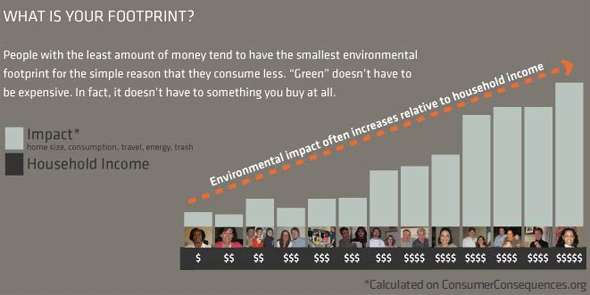Last Fall Grant Kristofek (“sustainability champion” at Continuum, the industrial design powerhouse responsible for the Reebok Pump and the OLPC) co-authored a report entitled Colorblind: How Consumers See Green. A team of designers, ethnographers and engineers visited households all over the US to document the attitudes that govern how we think and act with regard to the environment. Their studies include a set of priceless ethnographic interviews that reveal how little even educated consumers understand concepts such as footprint and global warming. They conclude that environmental impact has much more to do with income level than with intention or a true understanding of the problems. People who spend a lot of money have a much larger impact than those that consume less, regardless of how much they care. And it makes sense: people with more money have more stuff, bigger houses and they travel more. It appears that consumption pollutes, regardless of where it’s directed. The real challenge will be how to make people spend money without making them buy more stuff – something designers will have to wrap their heads around for a long time to come.
The conclusions from the study:
-People care about people; the environment only matters when it directly affects them. People care more that a natural pesticide, free of toxins, is safe for their family than safe for the environment.We need to tell them the whole story.
-We learned that people view the environment as abstract; as the place they occasionally “go out into,” not the place where they live. To engage people more with the environment, a stronger connection needs to be made to their everyday lives.
-People’s ideals were often inconsistent with the reality of their actions.Many beliefs they held about how to treat the planet were not carried out at home. Often it was the obvious, visible activities, such as recycling, that did receive their attention.
-Being green and buying green don’t go hand in hand. Those with lower income levels live more sustainably not necessarily for the benefit of the environment but simply because they consume less. Although living sustainably or being “environmental” is perceived as expensive, what we witnessed was quite the opposite.
